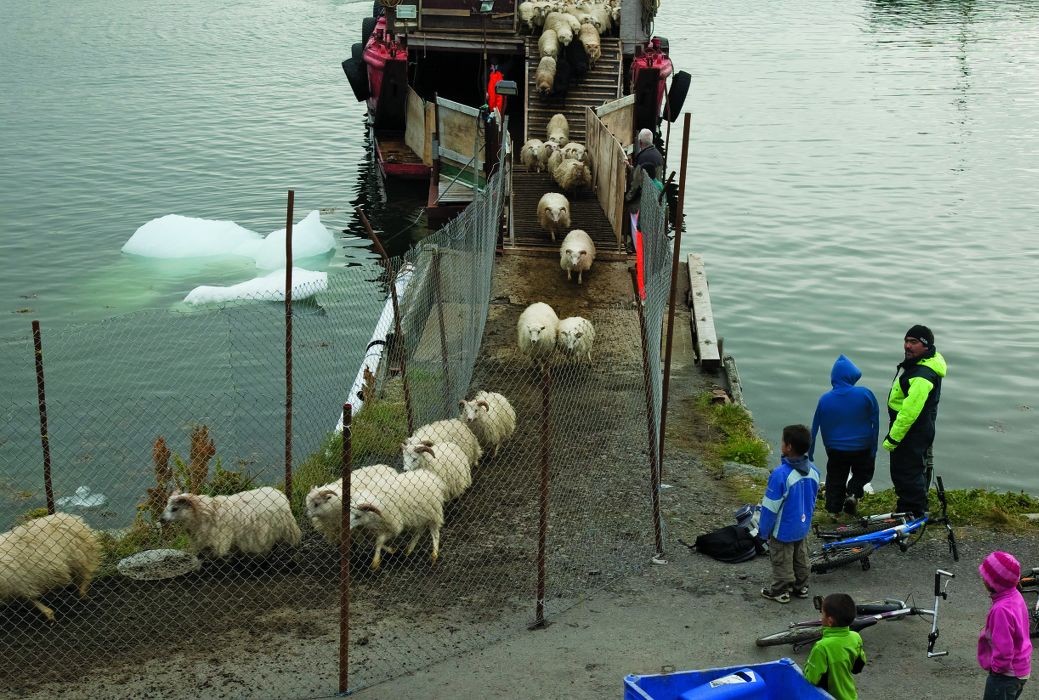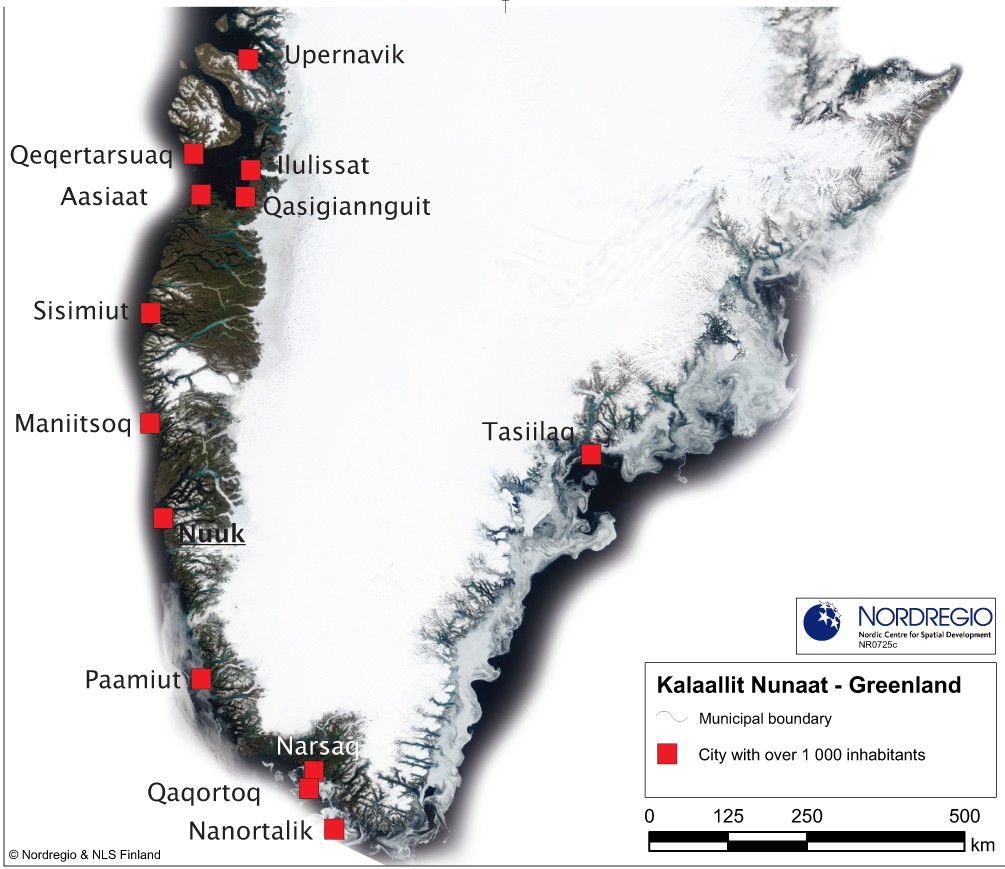
Sheep on their way to the slaughter house. Narsaq September 2008. Photo: Ole G. Jensen/arc-pic.com
One of the next big tasks will be to put an adaptation strategy in place. As with many other places across the globe Greenland is faced with the challenge of responding to the social aspects of changes in precipitation, water levels, wind speed and temperature. In addition, as an Arctic nation, Greenland has an additional and rather special factor, i.e. permafrost, to take into consideration.
One of the central tools used to deal with the social adaptation of these changes is physical planning (spatial planning). In connection with this, three of the most significant factors are: infrastructure, industry and population.
Infrastructure
Greenland is characterised by a small but dispersed population of 56 000 people divided into 75 inhabited areas (1 January 2009). There are no roads between the individual inhabited areas.
Most of the housing stock is grounded on bedrock and thus the loss of permafrost is not a significant problem in relation to buildings. The thawing of permafrost will however have severe consequences for the road and sewer systems of some towns. Similarly, it is likely that the airport runways will also be affected.
Greenland is accustomed to violent storms and there is no tree coverage to speak of, thus the increasing frequency of storms is not expected to have a major impact on the infrastructure endowment. Increases in the sea water level will however an impact on the nation's harbour facilities. Most of the 75 inhabited areas have a harbour. We already know that tidal differences vary up to five metres but if the highest water level was to rise even further then harbour facilities will need to be reorganised.
Industry
The occupational structure in Greenland varies a lot depending on where you are in the country. Furthest to the north and in East Greenland, sea mammal hunting remains the dominant way of life. There is no doubt that the disappearing sea ice is highly influential on these traditions.
According to the recent results produced by Rasmus Ole Rasmussen, who has conducted research on living conditions in the Arctic, there is a relatively limited group of older people who will be negatively affected. These are the sea mammal hunters who are not capable of converting from hunting with a dog sledge to alternative methods. A majority of hunters however expect to be able to amend their techniques in line with the changing climate and ice conditions and many of the younger people are expected to be able to take advantage of the fact that less sea ice leads to better opportunities for fishing from boats.
In the central part of West Greenland, where most of the inhabitants live, industrial fishing is one of the dominant industries. As a consequence of climate change the changes in the marine ecosystems around Greenland are expected to be comprehensive. The ecosystems that will be changed are very complex and there is no way to predict with certainty whether these changes will entail a basis for more or less commercial fishing in the waters around Greenland.
In the southern part of Greenland there is a well functioning agriculture industry. For example potatoes are grown, but the main industry is sheep breeding and around 20 000 lambs are slaughtered each year. Expectations have already been raised that the agriculture industry in South Greenland will benefit from the coming climate changes. The growth season will be prolonged and it will be possible to utilise new areas of land. Furthermore, in the coming years animal husbandry is likely to be expanded to include cattle.
Mining, oil and gas extraction and mega industry are the areas which the Kalaallit Nunaanni Namminersorlutik Oqartussat (Greenland home rule government) aims to extend. Because of the reduction of the Arctic sea ice cover, potential offshore oil and gas extraction will benefit from climate change and the warming of the oceans, as companies will increasingly benefit from opportunities to operate in areas which were previously unavailable.
There are clearly new opportunities for expansion in the areas where the inland ice is retracting and thereby exposing new unexplored areas of land potentially containing quantities of raw materials which could be of commercial interest. Recently, corporations with energy demanding production have also discovered the CO2-friendly energy potentials of exploiting Greenland's hydropower opportunities.
Population
In addition to the common tendencies in Greenland's societal and infrastructural development occupational changes in the coming years will be of significant importance for population development, including demographic development.
A large and recently conducted mobility study, along with other studies, points to the fact that a significant part of the population are relatively mobile and that up to two thirds are now considering moving elsewhere within Greenland. Furthermore, the attractions of globalisation are now gaining acceptance with the younger generations who know what the world's major cities have to offer and therefore to a greater extent see themselves as urban inhabitants, with the social opportunities that exist in these places, rather than as rural residents.
In combination these changing conditions suggest that in the coming years a significant redistribution of the population in relation to the 75 currently existing settlements is to be expected.
Planning
These immense transitions which can be predicted specifically in Greenland, and probably for all of the Arctic communities in general, set very high demands on the task of physical planning in these communities.
In Greenland, a digital geo-data platform, NunaGIS (see www.nunagis.gl) where the many different measurable factors will be made visible, has recently been established. Only by making visible the changes in all of the different parameters on a collective platform will societal physical planning be able to remain at the forefront of the significant transitions which are to come.
The changes which are caused by climate change should be registered and made visible along with other data. As such, a useful planning tool for future political decision making will be created, which will, in part, be conditioned by climate change and partly also by the general development of society.
Many of the changes which will take place in the Arctic will be of a transnational character and this will involve a special set of challenges which can only be overcome through close cooperation between the various Arctic nations. All of the Arctic communities are aware of this and a common Arctic Spatial Digital Infrastructure strategy is thus currently being drafted - an Arctic SDI strategy – which aims to ensure that the natural and societal changes of the coming years will be registered and made visible on a common Arctic digital geo-data platform.
If the necessary economic foundation is ensured, this trans-arctic planning tool will help the whole world to follow the radical changes in the Arctic in the coming decades. These changes will in the main relate to the climate changes caused by CO2 emissions in other parts of the world, but changes in the Arctic will have a 'boomerang effect' on the rest of the world. Therefore it is in everyone's interest to ensure the success of the Arctic SDI strategy and its matching planning tools.

The southern parts of Greenland already has some areas which can be used for rearing sheep and growing potatoes.
By Klaus Georg Hansen, Head of Department Spatial Planning Government of Greenland. Now at Nordregio.
The article was translated by Lise Smed Olsen